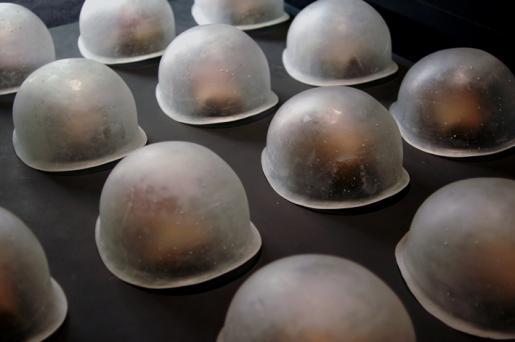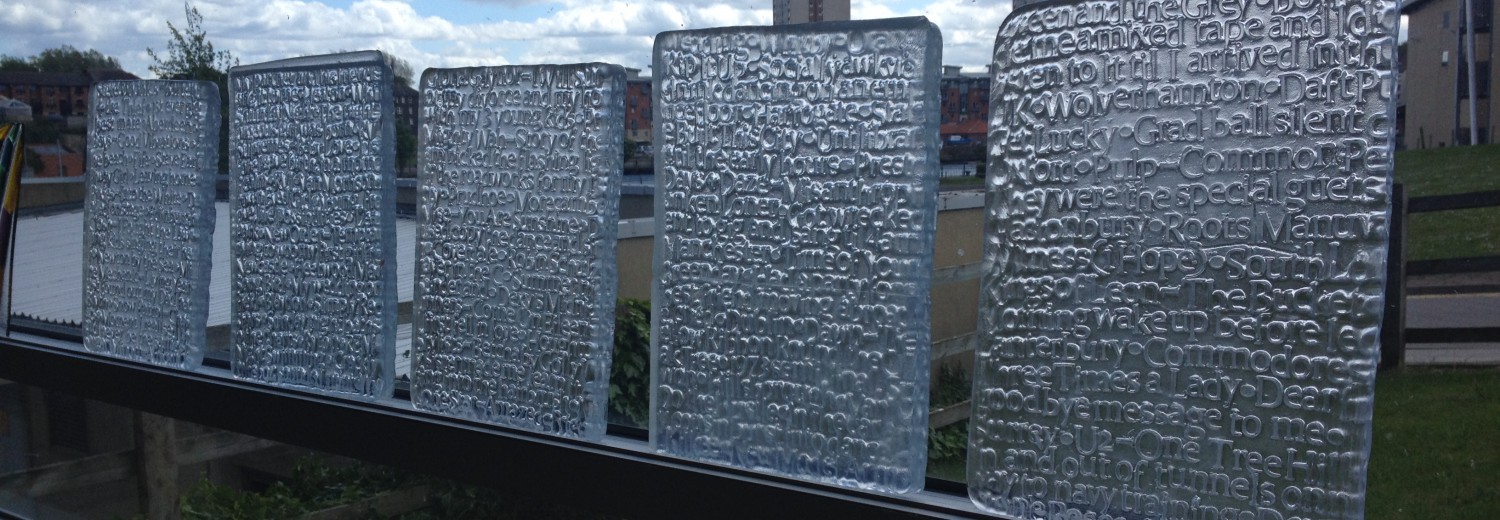As a Korean living and working in Edinburgh it is understandable to feel Keeryong’s frustration regarding the cultural differences. He suggests that glass art is a stranger to the contemporary Korean viewer.
The presentation of his career and influences was extremely hard to follow throughout and appeared a struggle for Keeryong to even express, which was evaluated at the end when he suggested that his usual style is completely different and much more relaxed and humorous but his love to tease his audience resulted in his dense, factual seminar to confuse.
The main area of focus for his work explores the cultural boundaries he has experienced as an immigrant. Keeryong explained how in daily life the divide is evident, from linguistic to cultural disconnection between himself and his peers.
Describing his home in Edinburgh as temporary, regardless of the fact he has lived there for decades, Keeryong hopes to explore the notion of familiarity with “home” and the individual sense of belonging. As an immigrant, he explains the emotional conflict of moving abroad, with a fear of losing your individuality or being different. He suggests that when you make the decision to move, you lose control and are living with uncertainty as you can no longer predict other people around you in their own culture.
It seemed sad to discuss anxiety as a student, or a traveller, or a migrant worker simply as a result of surrounding yourself with a new culture. This theme has cropped up frequently through the work of foreign artists, working in countries outside of their home.
Keeryong explained there is no objective assurance as “we” by the natives of the chosen country and how it is easy to feel like a stranger. He categorised “we” as a group of familiar people, “others” as a group of unfamiliar people (but recognisable) and strangers and being someone different or unknown. Throughout his portrayal of unease in a new society, Keeryong related back to scholars, professors and philosophers throughout, to back up his theory.
Described as a cross-cultural experience, following his upbringing and young adult life in Korea, after thirty years Keeryong moved to Edinburgh where he has inhabited for over a decade. He stated he has a steady communication with his family and friends in Korea but finds it increasingly difficult to describe it as his only home. When visiting Korea in 2013 for the first time in six years, Keeryong learned of his relationship to both his birthplace and his current home. He explained how he has often used his heritage as his excuse for language barriers and issues with integrating. This visit taught him that he is changing, as new Korean words are unfamiliar to him through not speaking in his mother tongue in Scotland. He suggests this could be another excuse to not find a place in Korea too. He asks “Am I Korean? What could the answer be now?”
Through Keeryong’s emotional changes regarding his home, he created the artwork ‘3rd Battalion 11th Company 1st Platoon’ in 2007. With cast glass helmets to represent the fragility of war and the vulnerability of soldiers alongside a voice recording of a Scottish man with a stammer reading a political speech, Keeryong hoped to make a statement of frustration regarding his own experiences with relation to the viewer.

Discussing his time in Korean National Service as a marine, Keeryong talked through the emotions of the military training process to graduation. He clearly recalls the day he graduated and how the solider is presented with their uniform as a form of prize. Each soldier’s civilian clothes are then packaged in brown paper and mailed to their family, which he described as a ceremonial event. Keeryong opened up about his own graduation and how his mother told him that the whole family cried over his clothes when they arrived at the family home. This idea was presented through this work under each translucent hat a pile of packaged clothes could be seen. The fragility of this piece expresses his identity shift and the vulnerability which is experienced. Many have described the layout as similar to a military graveyard and the viewer as a commander as you must stand in front of the rows of hats. By using a stuttering Scotsman, Keeryong hoped to create a sense of frustration for his new home and for the viewer as they must listen to the speaker struggle.
After focussing on his own cultural experiences, Keeryong then went on to express his understanding of other people’s cultures. He explained how in Britain he has visited Korean-style restaurants and seen decoration from various parts of Asia, with the owners claiming to provide an authentic Korean experience. Keeryong suggests this could become embarrassing, making a Korean feel uneasy as an inaccurate image of Korea is presented. Through his work ‘Begging Buddha I’, a group of religious figures are formed in a stance of begging and decorated on a setting with traditional Korean pattern, but using incorrect colour schemes to play with the expected. Set alongside a sound recording of traditional Buddhist chanting mixed with a hip-hop tempo, Keeryong hopes to portray this falseness through the inaccuracy of the elements in the piece. He explains how cultural clashes can sometimes create tension and he hopes to show this through his glass work.

After working and living in the UK for so longer and experiencing change when travelling back to Korea, Keeryong is now at a stage where he feels like he is unsure where he truly belongs, “I am between South Korea and here, I don’t belong to any.”
Working with British manufactured porcelain and combining it with glass, Keeryong created art to appear like Korean glass to the untrained eye. He found a youth trend of creating new words in Arabic “alien words” which are unrecognised unless you are taught them and began to create his own words with an Asian influence. Using the names of political figures and writing them backwards in an Arabic format, Keeryong was able to decorate his objects and present them in an authentic style tricking the viewer until they were told the truth behind the work.

After such a heavy presentation filled with facts and quotes, Keeryong ran out of time. He explained how he doesn’t always like to describe his work and actively avoids doing so. He enjoys teasing his viewers, suggesting he plays a game (much like he has done with his presentation to create a false image of himself).
